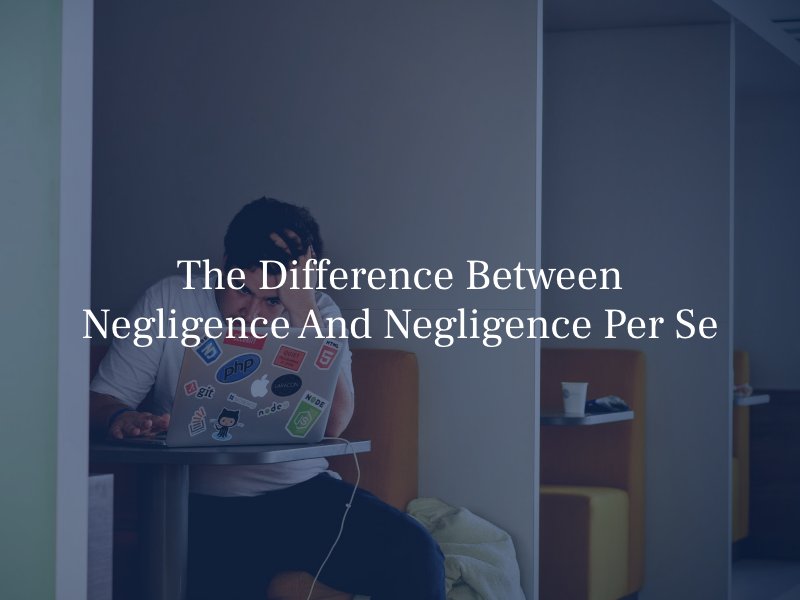The Difference Between Negligence And Negligence Per Se
July 15, 2023 Posted In Personal Injury
When it comes to Riverside personal injury cases, two terms that often come up are “negligence” and “negligence per se.” While both involve a breach of duty that leads to harm or injury, they have distinct differences in their application and legal significance.

Negligence
Negligence is a legal theory that forms the basis of many personal injury claims. It refers to the failure to exercise reasonable care in a given situation, resulting in harm or injury to another person.
As an example, suppose an individual named John is driving their car on a busy highway and texting. As a result, John fails to notice the traffic slowing down ahead and rear-ends the car in front of them, causing significant damage to both vehicles and injuring the other car’s driver. In this case, John’s actions demonstrate negligence.
Proving Negligence
To establish a claim of negligence, the following elements must typically be proven:
- Duty of care: The defendant (at-fault party) owed a duty of care to the plaintiff (injury victim), implying that they had a legal obligation to act reasonably and prevent foreseeable harm (e.g., John owed a duty to others on the road to drive safely and follow traffic laws).
- Breach of duty: The defendant breached the duty of care by failing to meet the standard of care expected in the specific circumstances (e.g., John sent a text while driving and was not paying attention to the road)
- Causation: The defendant’s breach of duty was the direct cause of the plaintiff’s harm or injury (e.g., John was distracted and crashed into the victim’s car).
- Damages: The plaintiff suffered actual damages or losses as a result of the defendant’s breach of duty (e.g., The victim was injured in the crash and requires compensation for medical bills, lost income, pain and suffering, etc.).
Negligence Per Se
Negligence per se is a legal doctrine that arises when an individual violates a specific statute or regulation enacted to protect a certain class of individuals from harm. Unlike general negligence, negligence per se simplifies the process of proving negligence by establishing a presumption of negligence once the violation of the statute is proven.
For instance, let’s say an individual named Mary operates a daycare center that is subject to strict safety regulations, one of which requires the installation of childproof locks on all doors to prevent children from accessing potentially dangerous areas. Mary did not install a childproof lock on the door leading to the basement, and a child wanders and sustains injuries from falling down the stairs. In this case, Mary’s actions may be considered negligence per se based on the violation of a specific statute or regulation.
Proving Negligence Per Se
To establish a claim of negligence per se, the following elements are typically required:
- Statute or regulation: There must be an applicable statute or law that sets forth a particular standard of conduct (e.g., Childproof locks are required on all doors in a daycare center).
- Violation of the statute: The defendant must have violated the specific statute or regulation (e.g., Mary failed to comply with the law by not installing a childproof lock on the basement door).
- Protected class: The plaintiff must be a member of the class of individuals the statute was intended to protect (e.g., The law on childproof locks protects children in daycare centers, and the child who fell down the stairs is a member of this protected class).
- Causation: The violation of the statute must have been the proximate cause of the plaintiff’s harm or injury (e.g., Mary’s failure to install the childproof lock directly resulted in the child’s injuries).
Key Differences
The key differences between negligence and negligence per se are as follows:
Applicability
Negligence per se is typically applicable in situations where a statute or regulation directly addresses the conduct that caused the harm. General negligence, on the other hand, is more broadly applicable to a wide range of situations.
Standard of Care
In general negligence cases, the standard of care is based on what a reasonable person would do in a similar situation. However, in negligence per se cases, the standard of care is defined by the statute or regulation that was violated.
Burden of Proof
In general negligence cases, the burden of proof rests on the plaintiff to establish the elements of negligence. In negligence per se cases, once the violation of the statute is proven, the burden shifts to the defendant to prove that they acted with reasonable care despite the violation.